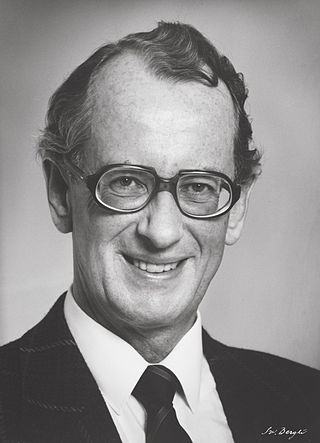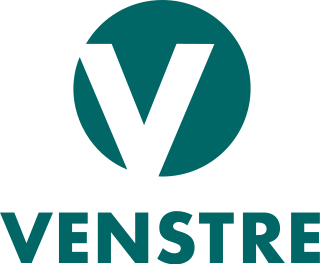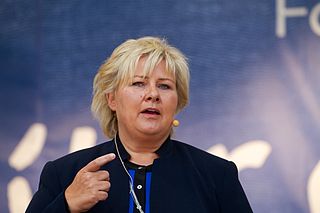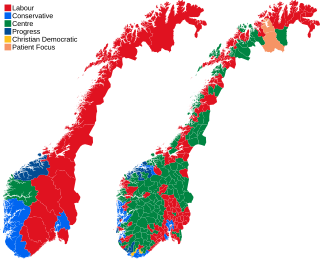The politics of Norway take place in the framework of a parliamentary, representative democratic constitutional monarchy. Executive power is exercised by the Council of State, the cabinet, led by the prime minister of Norway. Legislative power is vested in both the government and the legislature, the Storting, elected within a multi-party system. The judiciary is independent of the executive branch and the legislature.

Kjell Magne Bondevik is a Norwegian Lutheran minister and politician. As leader of the Christian Democratic Party, he served as the 33rd prime minister of Norway from 1997 to 2000, and from 2001 to 2005, making him, after Erna Solberg, Norway's second longest serving non-Labour Party prime minister since World War II. Currently, Bondevik is president of the Oslo Centre for Peace and Human Rights.

was a Norwegian lawyer and politician from the Conservative Party. He was the 31st prime minister of Norway from 1989 to 1990. He also served as the minister of Industry from 1983 to 1985. Syse was the president of the Lagting 1993–1997. Syse was the president of the Nordic Council in 1988 and 1993. He served in the Norwegian parliament for over 25 years until his sudden death from a cerebral hemorrhage in 1997.

Kåre Isaachsen Willoch was a Norwegian politician who served as the 30th prime minister of Norway from 1981 to 1986 and as leader of the Conservative Party from 1970 to 1974. He previously served as the Minister of Trade and Shipping from August to September 1963 and 1965 to 1970, and as the president of the Nordic Council in 1973.

The Centre Party, formerly the Farmer's Party, is an agrarian political party in Norway.

Erna Solberg is a Norwegian politician and the current Leader of the Opposition. She served as the 35th prime minister of Norway from 2013 to 2021, and has been Leader of the Conservative Party since May 2004.
The Conservative Party or The Right is a liberal-conservative political party in Norway. It is the major party of the Norwegian center-right, and was the leading party in government as part of the Solberg cabinet from 2013 to 2021. The current party leader is former Prime Minister Erna Solberg. The party is a member of the International Democrat Union and an associate member of the European People's Party.

The Liberal Party is a centrist political party in Norway. It was founded in 1884 and it is the oldest political party in Norway. It is positioned in the centre on the political spectrum, and it is a liberal party which has over the time enacted reforms such as parliamentarism, freedom of religion, universal suffrage, and state schooling.

Kristin Clemet is a Norwegian politician for Høyre, Norway's Conservative Party.
Tore Austad is a Norwegian politician for the Conservative Party. Born in Skedsmo, Akershus, he received a cand. philol. degree in 1962, and worked as a professor of Norwegian at the University of Chicago from 1964 to 1966. Returning to Norway he worked at various academic institutions, before being elected to the Storting from the county of Vest-Agder in 1977, where he sat for three periods, until 1989.

The Minister of Energy is a councilor of state and chief of the Norway's Ministry of Petroleum and Energy. The current minister is Terje Aasland. The ministry is responsible for the government's energy policy, including management of Norway's energy resources, including the valuable deposits of petroleum and hydroelectricity. Major subordinate agencies and companies include the Water Resources and Energy Directorate, the Petroleum Directorate, Petoro, Gassnova, Gassco, Enova, Statnett and a partial ownership of Statoil. The position was created on 11 January 1978 as a response to the increased importance of oil on the Norwegian continental shelf. The position was merged with the Minister of Trade and Industry between 1992 and 1996. It was renamed Minister of Energy starting from 1 January 2024.

The Minister of Culture and Equality is a councilor of state and chief of the Norway's Ministry of Culture and Equality. The ministry is responsible for the government's policy related to culture, church affairs, religion, media, sports and gambling. Subordinate agencies include the Gaming and Foundation Authority, the National Archival Services, the National Library, the Arts Council and the Media Authority. The portfolio includes issues related to the Church of Norway.

Brundtland's First Cabinet was a minority, Labour Government of Norway. It succeeded the Labour Cabinet Nordli, and sat between 4 February and 14 October 1981. The cabinet was the first in Norwegian history to be led by a woman. It was replaced by the Conservative Willoch's First Cabinet after the 1981 election.

Brundtland's Second Cabinet was a minority, Labour Government of Norway. It succeeded the Conservative Willoch's Second Cabinet, and sat between 9 May 1986 and 16 October 1989. It was replaced by the Conservative/Centre/Christian Democrat cabinet Syse after the 1989 election. The cabinet was historic in that 8 of the 18 members were female, to then the highest female share in a government ever in the world.
Willoch's First Cabinet was a minority, Conservative Government of Norway. It succeeded Brundtland's First Cabinet, after the Conservative victory in the 1981 Storting election; and sat from 14 October 1981 to 8 June 1983. It was replaced by Willoch's Second Cabinet, a coalition of the Conservative, Centre and Christian Democrat parties to form a majority government. Willoch's First Cabinet was the first Conservative-only cabinet since Stang's Second Cabinet of 1893–95, and there has not been another Conservative-only cabinet since.

Odd Arild Kvaløy is a Norwegian politician for the Centre Party. He is best known as the county mayor of Rogaland from 1991 to 1999, being Rogaland's first county mayor to win re-election.

The Minister of International Development is a councillor of state and the chief of the international development portfolio of the Ministry of Foreign Affairs of Norway. The ministry was responsible for the foreign service, the country's international interests and foreign policy. Most of the ministry's portfolio is subordinate to the Minister of Foreign Affairs. The prime operating agency for international development is the Norwegian Agency for Development Cooperation. The position has been held by ten people representing five parties.

The Solberg Cabinet was the government of the Kingdom of Norway, headed by Conservative Party leader Erna Solberg as Prime Minister from 16 October 2013 to 14 October 2021. The government was appointed by King Harald V on 16 October 2013 following the parliamentary election on 9 September, consisting of the Conservative Party and the Progress Party as a minority government. On 16 December 2015, the cabinet was re-shuffled. The government secured renewed support following the 2017 parliamentary election. It was expanded on 14 January 2018, when an agreement was reached to include the Liberal Party, and further expanded on 22 January 2019 when the Christian Democratic Party joined the coalition. On 20 January 2020, the Progress Party announced that it would withdraw from the government, citing the decision to bring home the family of a sick child from Syria, which included the child's mother, a Norwegian citizen who had volunteered for the Islamic State.

Parliamentary elections were held in Norway on 13 September 2021. All 169 seats in the Norwegian legislature, the Storting, were up for election.












